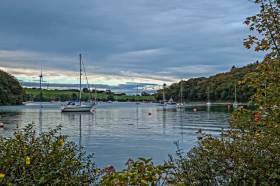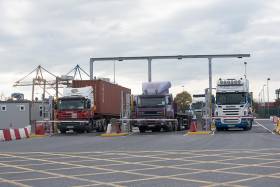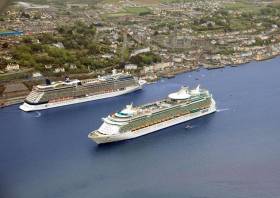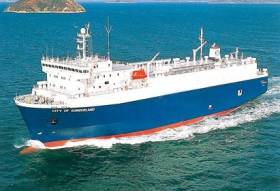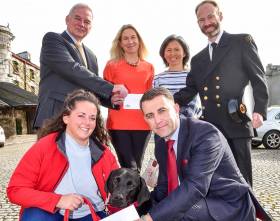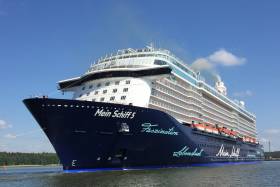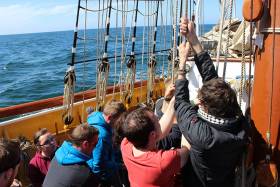Displaying items by tag: port of Cork
Port of Cork Venue for 2017 ISA Cruising Conference
After the inaugural success of the Howth Yacht Club 2016 Cruising Conference, the Irish Sailing Association is bringing the one day event to Cork Harbour at the Port of Cork Offices on Saturday, 18th February 2017.
Last year's conference featured a wide range of topics and featured on Afloat.ie here.
Port of Cork's New Automated Gate Operating System is First in Ireland
The Port of Cork Company (POCC) has announced the recent introduction of a new €750,000 automated gate operating system for its Tivoli Container Terminal. The new system will help support terminal efficiency and modernise the container collection and delivery process at the busy marine terminal and it is the first of its kind to be introduced in Ireland.
The Port have implemented an integrated IT access management system that will improve transactions for hauliers at the terminal gate. The new gate operating system replaces the former gate-in and gate-out procedure, which operated for many years at the terminal, and is the culmination of a five year objective. Included in the process was a joint collaboration between the Port of Cork and Customs & Revenue to establish a customs clearance verification system.
The new high-tech Gate Operating System will record important data for all deliveries and collections at the Terminal, including license plates, container details, container damages and security seal presence and utilizes modern technologies and industry practices observed at terminals operating in mainland Europe.
In the event of any difficulty, the new Gate Operating System contains a problem resolution area where any potential issues encountered by the haulier can be addressed prior to containers being delivered and/or collected. Only those trucks that have been processed correctly can enter the Container Terminal Gate and the Loading/Unloading area, which improves flow at the busy interface. The new Gate Check in Area is monitored by a central control station and can also assist hauliers as required.
Olan O’Keeffe, Terminal Operations Manager, Port of Cork, says, “Ports and terminals are dynamic environments with very specific needs and the Port of Cork Company prides itself on being at the forefront of the industry when it comes to adapting to change and in consistently achieving the highest operational standards”.
“The introduction of this modern Gate Operating System will assist in improving terminal turnaround times, increase our throughput capacity, improve efficiency, drive revenue, integrate with Customs systems and provide us with important management reporting data such as how many trucks visited the terminal during a particular day, week or month and how long trucks stayed at the terminal on average. Image recording will also assist us in claims management.”
He continued, “The introduction of the Gate Operating System at Tivoli will also contribute to the Port’s plans to develop its new facility at Ringaskiddy. As part of that proposal the Port has committed to implementing a Traffic Mobility Management plan in Ringaskiddy, and a fully automated gate system and vehicle booking system will form an important part of that Plan. The new system at Tivoli will provide us with valuable hands on experience of what such a facility can contribute to traffic mobility”.
The continued use of the Port’s online portal (portal.portofcork.ie) is recommended to hauliers to ensure containers are booked in, released and customs cleared, etc. Further developments are planned to improve information for transport operators through this portal, in order to communicate key information that will be required in relation to the availability of containers for customers.
No Single Port – Ireland Needs Them All for Cruise Ship Business
The cruise ship industry is a huge and growing business …. The “ship hotel” as it has been dubbed. There is huge competition amongst the companies which own the ships and amongst the ports which want them to call. More, bigger cruise ships than ever have been and are being built, with ever-bigger passenger capacity. The Cruise Line International Association Europe said last year that the contribution of Cruise Ship Tourism to the economies of Europe was worth €40 billion and accounted for nearly 350,000 European jobs and that Europe was the second biggest market worldwide, after the United States.
Ireland has been attracting plenty of cruise ship business. Last year 193 vessels called to Irish ports - Dublin and Cork being the main locations, followed by Waterford, with Dun Laoghaire, Killybegs, Foynes and Bantry Bay also calling-locations. That number of ships was an increase of 16 and the number of passengers was close to 250,000 – an increase of almost 40,000 - on the previous year. As dictated by Government policy, the ports are in competition with each other and the cruise ship business is one of their primary targets, though port administrations say that local businesses and the economy generally benefits more than they do from calls by cruise ships.
With more ships being built, many with bigger-than-ever passenger capacity, is the best approach for Ireland that its ports should be competing with each other for the business?
That’s the question I have been discussing on THIS ISLAND NATION Podcast this week, with a man in a position to see both sides, Capt. Michael McCarthy is Cork Port’s Commercial Manager and also Chairman of Cruise Europe. I talked to him in Cobh, as the town celebrated its latest international award for the handling of cruise ships.
• Listen to the Podcast below:
#UNship - Mainport Cedar, which carried out a UN World Food Program to war-torn Yemen is on her first visit to Cork City where her Irish owners are based, writes Jehan Ashmore.
It was during the 9 month contract to the UN that the seismic support vessel which also is a supply ship carried out the unusual role of making humanitarian transportation voyages. The charter of the ship to the Arab country ceased earlier this year.
Mainport Cedar has accommodation for 50 (10 officers and 40 marine crew) and a 1-bed hospital unit. During its UN charter role, the vessel transported UN personnel to Yemen.
As previously reported the 1,659 gross tonnage ship is the leadship of a pair built in Malaysia as the first purpose built seismic support ships for the Mainport Group. The 2013 built ship is berthed at Cork along Albert Quay, adjacent to the Port of Cork’s City Centre Marina.
The reason for the first call of the 53m vessel is due to the completion of a project in the Bristol Channel.
As for the next project, it would appear that Mainport Cedar is next bound for Nassau, Bahamas, though Mainport declined to confirm that the Caribbean island is the next area of operation.
Operating much closer to home, Mainport have the contract to serve the Kinsale Gas Field. This is carried out by the multi-role support vessel Pearl out of Ringaskiddy, lower Cork Harbour. It was here that Celtic Fergus, the latest acquisition for subsidiary Celtic Tugs was delivered by cargoship earlier this year.
Reports of Nissan Eyeing Up Cork Site "Just Not True"
#CorkCars? - Nissan Europe have dismissed speculation, writes TheJournal.ie, that it is interested in taking over a site south of Cork City at the 130-acre former Amgen facility in Carrigtwohill.
Fianna Fáil city councillor Kenneth O’Flynn had claimed that he had been tipped off by industry insiders that the Japanese automobile production giant may be interested in locating to east Cork.
Nissan Europe’s lukewarm response as to whether it was fully committed to Sunderland in the north- east of the UK in the wake of Brexit had increased speculation about its future plans.
However, a spokesperson for Nissan Europe was unequivocal in her response when contacted by the Evening Echo. She said: “There’s nothing to this tip-off.”
To read more and of the FF councillor views on the use of Port of Cork click here.
In addition see: Seatruck’s new Dublin-Bristol trade car route that follows in the wake of 1970's car industry serving Dublin and notably the Port of Cork and related former Ford assembly plant.
Port of Cork Cyclists Raise Valuable Funds for Two Charities
The Port of Cork had a team of over 90 cyclists who recently completed the An Post Rebel Tour cycle from Glengarriff. Cyclists from a range of port related companies took part in the cycle which was co-sponsored by the National Maritime College of Ireland (NMCI) and Zenith Energy Management Ltd. Together the cyclists raised over €1800 for Autism Assistance Dogs Ireland and over €1100 for the Seamen’s Christian Friends Society.
Cyclists chose either 85km or 160km routes across which led them to West Cork and into Kerry.
Brendan Keating, Port of Cork Chief Executive said: “This is our third year organising the cycle which was by far the biggest turnout of cyclists to date. We were delighted to partner with NMCI and Zenith Energy Management Ltd and as result two very deserving charities benefitted from our cyclists generous donations.’
He continued: ‘I’d like to congratulate all those who took part and thank you for your kind donations.’
The Seamen’s Christian Friend Society (SCFS) is based in 40 ports around the world and spends their days boarding ship after ship, meeting and assisting crews. Over a million men and women live in the twilight world of big shipping and it’s a lonely life roaming the world's oceans for up to 12 months at a time. An SCFS Friend brings a welcome, an offer of friendship or a chance for a sympathetic talk and news of the Christian gospel to crews.
Autism Assistance Dogs Ireland is a national charity providing highly trained assistance dogs for children with autism and their families. The dogs are specially trained to provide safety, independence and companionship to children who would otherwise live in a very isolated world. These dogs help to transform the lives of children and their families.
Cobh Named One of Western Europe’s Best Cruise Destinations for British Isles & Western Europe
Cruise Critic, a world leading cruise review site and online cruise community, has announced the winners of the inaugural Cruise Critic Cruisers’ Choice Destination Awards with Cork harbour’s Cobh ranked second favourite cruise destination in the British Isles and Western Europe.
As Afloat.ie reported yesterday, The awards name the best cruise destinations of the year – across 15 regions around the world – based entirely on reviews posted by cruise passengers to the Cruise Critic website.
For the British Isles and Western Europe awards, Amsterdam was rated top, while Cork’s Cobh and Glasgow’s Greenock ranked second and third respectively.
These awards recognise the high level of effort that goes into ensuring every cruise passenger visiting Cobh has a memorable visit to the region. With the awards based solely on passenger feedback there is no ambiguity around results – what you read is what you get!
Captain Michael McCarthy, Commercial Manager, Port of Cork said: “We are simply thrilled with the result for Cobh. Every year the Port of Cork puts a huge amount of effort into preparing and promoting the Cork region to the cruise companies and their passengers and this has really paid off.’
He continued: ‘This is an example of a genuine collaborative team effort. It could not be done without an extremely dedicated group of people who believe in our destination. Prior to the vessels arrival the port company promotes the region’s attractions directly to cruise passengers on board the liners. Once the liner arrives, our Port Pilot steps on board and really this is the beginning of the welcome. From there we offer tourism ambassadors on every liner, local entertainment and then, as their visit ends we have the Cobh Brass band on the quayside as the liner departs.’
‘This award is about a port and a City working together to make the passenger experience entirely better.’ One cruise passenger who commented said “Beautiful city with very friendly locals.” what more could we ask for.’
According to Adam Coulter, UK editor, Cruise Critic: “A cruise isn’t just about the ship – picking the right itinerary is imperative. Cruises enable travellers to explore a number of amazing destinations, offering culture, beauty and history. With such a variety of unique destinations to choose from, these awards aim to highlight, and celebrate, those rated highly by travellers to offer inspiration and guidance to cruise planners.”
The Port of Cork cruise business continues to go from strength to strength with 58 cruise calls this year and 66 cruise calls expected in 2017. To date 118,000 passengers and crew have visited the region and with a further seven liners due to call, these numbers will increase.
Cork's Cobh Listed in Top Three Destinations In Worldwide Cruise Critic Traveller Awards
#CobhAward – TripAdvisor which owns Cruise Critic, the world's largest cruise review site and online cruise community, has announced Cobh as among the winners of the inaugural Cruise Critic Cruisers’ Choice Destination Awards.
In the British Isles and Western Europe awards, Cork’s Cobh was ranked second place, Glasgow’s Greenock ranked third, leaving Amsterdam to top the list in first place, with calls to the Dutch destination from the likes of Regent Seven Seas and Azamara Club Cruises.
The awards name the best cruise destinations of the year – across 15 regions around the world – based entirely on reviews posted to the Cruise Critic website. All rankings are based on member review ratings for ports from sailings taken August 1, 2015 to July 31, 2016.
“A cruise isn’t just about the ship – picking the right itinerary is imperative,” explains Adam Coulter, UK editor, Cruise Critic. “Cruises enable travellers to explore a number of amazing destinations, offering culture, beauty and history. With such a variety of unique destinations to choose from, these awards aim to highlight, and celebrate, those rated highly by travellers to offer inspiration and guidance to cruise planners.”
Popular ports include the Caribbean’s St. Maarten, which receives visits from lines including P&O Cruises, Royal Caribbean and MSC Cruises, and Alaska’s Glacier Bay which is visited by a number of cruise lines including Norwegian Cruise Line and Holland America Line.
The British love the Baltics - UK travellers rated Baltic destinations in their top three, with Stockholm first, followed by Tallinn and Copenhagen.
Winds of Change Channel New Cruiseship Call to Cobh Instead of Capital
#WindsofChange – Afloat.ie has monitored Mein Schiff 5 movements noting the new cruiseship less than two months in service was forced to change its first ever call to an Irish port today, writes Jehan Ashmore.
It transpired that high winds forecast at Dublin Port were the cause and so the 2,750 passenger cruiseship had to call to Cobh, where the 295m newbuild berthed this morning but was due to call anyway tomorrow. Cruisegoers will not be left dissappointed as the near 100,00 gross tonnage ship will be simply swapping ports with the scheduled call to the capital a day later.
The impact of windage on the TUI Cruises newest ship with 15 decks high had to be considered when berthing in the confines of Dublin Port, where most callers are to Alexandra Basin.
Dublin Port Company’s first ever cruise terminal costing €30m is part of the Alexandra Basin Redevelopment Project (ABR) which is been built to accommodate even larger cruiseships and following a major dredging channel campaign.
A reconfiguration of quays will enable these mega cruiseships to call using an increased turning circle though at the expense of demolishing the end of the North Wall Quay Extension.
More quayside space and adjacent hard standing for cargo space, however will be made with the infilling of the Dublin Graving Docks that closed in April.
The ABR project is phase one of DPC plans to also permit increasingly larger cargsoships and associated deeper drafts to enter the port, so to meet demands of throughput which is forecast to rise, as the port in 2015 alone experienced record breaking volumes.
The 220m graving dock is nearby to where these mega cruiseships will dock at the two-berth terminal and much closer to city-centre, been next to the Tom Clarke toll-bridge.
Tall Ship Celebrations for Cork Sail Training Bursary Scheme
32 young people from all backgrounds and a range of abilities across Cork City and County who have completed Tall Ship voyages aboard the Cork-Based Vessel Spirit of Oysterhaven and the Dutch Tall Ship Morgenster during the 2016 season will celebrate their achievements in Cork today.
The voyages were made possible by the assistance of a group of sponsors including Port of Cork, Cork City Council, Cork County Council, EMC, Ardmore Shipping, The Institute of Master Mariners and the National Maritime College of Ireland.
Due to extra support from Port of Cork, Cork County Council and Cork City Council Morgenster made a visit to Cork in June and hosted events and “open-ship” for public visits in Cork City and in Cobh during the Cork Harbour Festival 2016.
13 trainees from the City and County sailed the ship over 12 days from Belfast, via Isle of Man to Cork. Another 3 Cork trainees sailed from Cork to Amsterdam over 19 days arriving in Amsterdam at the end of June. These trainees formed part of groups with up-to 32 trainees and mentors on each voyage which were part funded using EU “Erasmus +” funding and involved active educational programmes of youth development as part of “Youth Exchange” projects.
The Cork Sail Training Bursary Scheme was established in 2014 to provide access to Sail Training voyages on tall ships and large sailing vessels for young people from the region. Now in its third year the scheme is one of the largest and most active on the Island of Ireland and runs in parallel with similar schemes now in operation under Sail Training Ireland in Belfast, Drogheda, Dublin, Waterford, Wexford, Limerick and Galway. The participants are nominated through a network of youth and community groups in Cork and places are available to young people from all backgrounds and with all abilities.
The scheme has supported approximately 50 trainees since 2014 and looks likely to grow from strength to strength over the coming years.
Also present on the day will be trainees sponsored under one of Sail Training Ireland’s “SafeHaven Voyages” sponsored by “Arthur Cox”. Their voyage on board the “Spirit of Oysterhaven” finishes today, following six days at sea beginning in Glandore County Cork. The vessel will be in Port of Cork and open to visitors after the event.
“The whole experience since we first met until the last moment I will never forget. The scenery, the sea sickness, the lifestyle and most of all the people I spent this journey with. I’ve made some lovely friends and will never forget them.” Cork Trainee 2015.
MC for the event is RTE Radio “SeaScapes” Presenter Marcus Connaughton (Goodwill Ambassador for Sail Training Ireland) and the certificates will be presented to trainees by Commodore Hugh Tully - Flag Officer Commanding Naval Service (F.O.C.N.S.). The Naval Service is a strong supporter of Sail Training for young people as a stepping stone into maritime careers and has recently made the Naval Yacht “Creidne” available for voyages for young people selected by Sail Training Ireland.


























